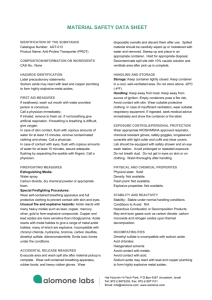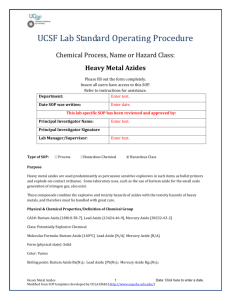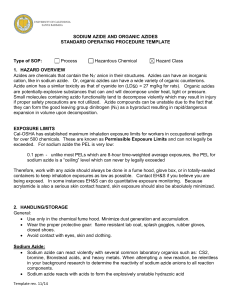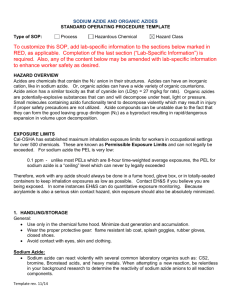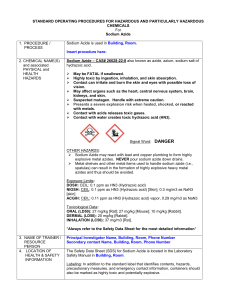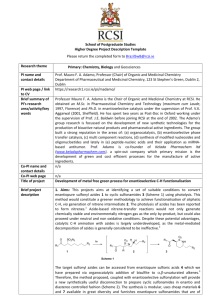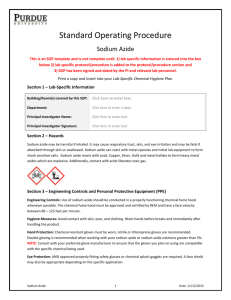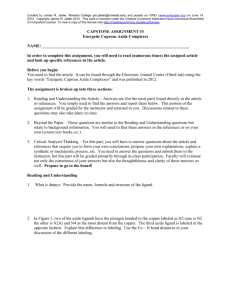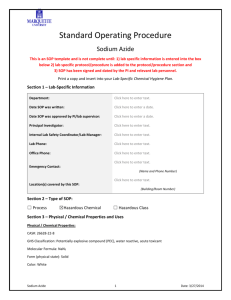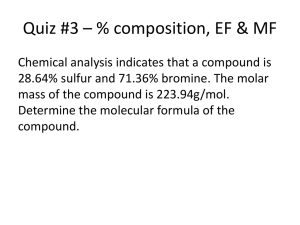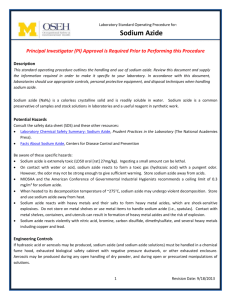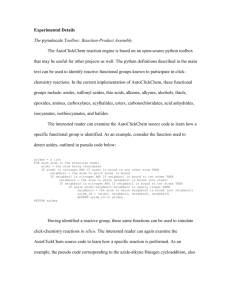By utilizing the temperature dependence of the reaction rate
advertisement
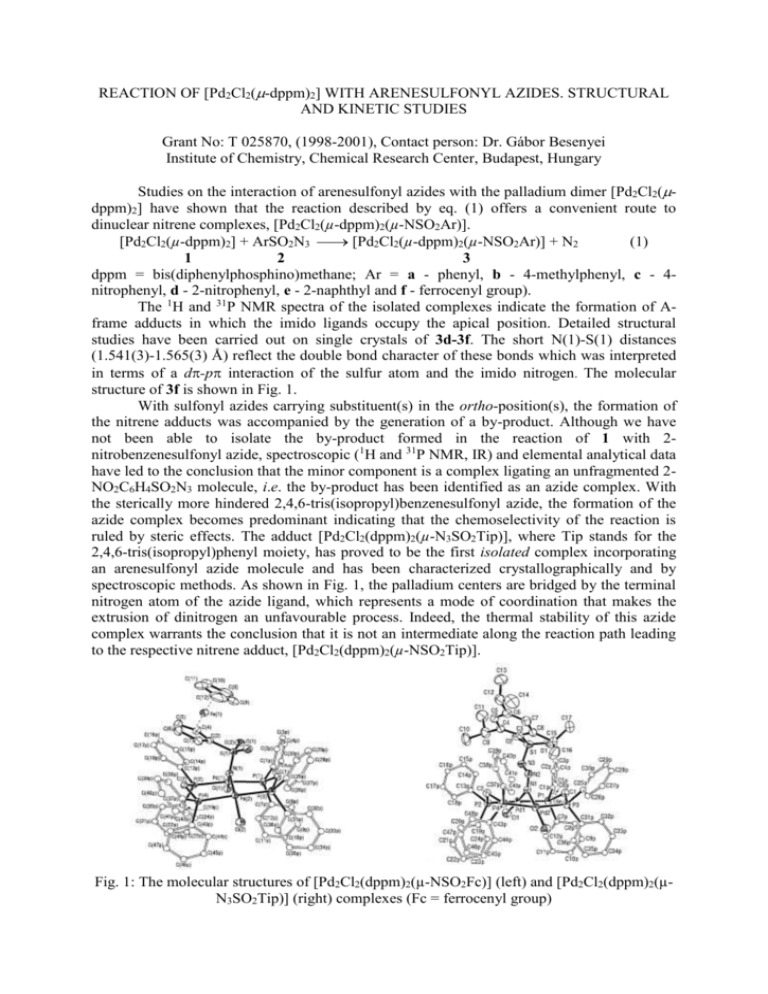
REACTION OF [Pd2Cl2(-dppm)2] WITH ARENESULFONYL AZIDES. STRUCTURAL AND KINETIC STUDIES Grant No: T 025870, (1998-2001), Contact person: Dr. Gábor Besenyei Institute of Chemistry, Chemical Research Center, Budapest, Hungary Studies on the interaction of arenesulfonyl azides with the palladium dimer [Pd2Cl2(dppm)2] have shown that the reaction described by eq. (1) offers a convenient route to dinuclear nitrene complexes, [Pd2Cl2(µ-dppm)2(µ-NSO2Ar)]. [Pd2Cl2(µ-dppm)2] + ArSO2N3 [Pd2Cl2(µ-dppm)2(µ-NSO2Ar)] + N2 (1) 1 2 3 dppm = bis(diphenylphosphino)methane; Ar = a - phenyl, b - 4-methylphenyl, c - 4nitrophenyl, d - 2-nitrophenyl, e - 2-naphthyl and f - ferrocenyl group). The 1H and 31P NMR spectra of the isolated complexes indicate the formation of Aframe adducts in which the imido ligands occupy the apical position. Detailed structural studies have been carried out on single crystals of 3d-3f. The short N(1)-S(1) distances (1.541(3)-1.565(3) Å) reflect the double bond character of these bonds which was interpreted in terms of a d-p interaction of the sulfur atom and the imido nitrogen. The molecular structure of 3f is shown in Fig. 1. With sulfonyl azides carrying substituent(s) in the ortho-position(s), the formation of the nitrene adducts was accompanied by the generation of a by-product. Although we have not been able to isolate the by-product formed in the reaction of 1 with 2nitrobenzenesulfonyl azide, spectroscopic (1H and 31P NMR, IR) and elemental analytical data have led to the conclusion that the minor component is a complex ligating an unfragmented 2NO2C6H4SO2N3 molecule, i.e. the by-product has been identified as an azide complex. With the sterically more hindered 2,4,6-tris(isopropyl)benzenesulfonyl azide, the formation of the azide complex becomes predominant indicating that the chemoselectivity of the reaction is ruled by steric effects. The adduct [Pd2Cl2(dppm)2(µ-N3SO2Tip)], where Tip stands for the 2,4,6-tris(isopropyl)phenyl moiety, has proved to be the first isolated complex incorporating an arenesulfonyl azide molecule and has been characterized crystallographically and by spectroscopic methods. As shown in Fig. 1, the palladium centers are bridged by the terminal nitrogen atom of the azide ligand, which represents a mode of coordination that makes the extrusion of dinitrogen an unfavourable process. Indeed, the thermal stability of this azide complex warrants the conclusion that it is not an intermediate along the reaction path leading to the respective nitrene adduct, [Pd2Cl2(dppm)2(µ-NSO2Tip)]. Fig. 1: The molecular structures of [Pd2Cl2(dppm)2(µ-NSO2Fc)] (left) and [Pd2Cl2(dppm)2(µN3SO2Tip)] (right) complexes (Fc = ferrocenyl group) The azide complexes have proved to be light sensitive and irradiation with sunlight has caused their decomposition to the parent dimer and free sulfonyl azides. Kinetic studies on reaction (1) have revealed first-order dependence of the reaction rate on both reacting partners: v = k’[Pd2Cl2(-dppm)2] = k[Pd2Cl2(-dppm)2][ArSO2N3] The observed kinetic behavior and the activation parameters are consistent with an associative bimolecular mechanism involving a transition state with a relatively small extent of bond breaking but extensive ordering of the reactants and solvent molecules. Electron withdrawing substituents on the aryl group increase the reaction rate, indicating that the azides studied act as electrophiles in reaction (1). Our search on the structure-reactivity relationship has demonstrated that not only the log(k/kH) values but also the position of the as(N3) band of the para-substituted arenesulfonyl azides show a linear dependence on Hammett’s constants. Table 1: IR spectroscopic data and second-order rate constants of arenesulfonyl azides Aryl group 4-NO2C6H4 4-CH3C(O)C6H4 4-FC6H4 C6H5 4-CH3C6H4 4-CH3OC6H4 2-NO2C6H4 ν/cm-1 2131.2 2128.1 2127.3 2126.9 2125.0 2123.8 2147.7 k/M-1s-1 0.406 0.104 0.044 0.0258 0.0161 0.0140 0.058 Spectroscopic and kinetic investigations with 2-nitrobenzenesulfonyl azide, 2d, seem to contradict all the conclusions made in conjunction with the para-substituted reagents. The as(N3) band of the most reactive azide (2c) shows up at 2131.2 cm-1, while the same vibration of 2d appears at 2147.7 cm-1. This remarkably high value is not accompanied, however, by an increased reactivity of 2d toward 1, as could be expected from a simple extrapolation of the spectroscopic and kinetic data. Crystallographic studies on 2-nitrobenzenesulfonyl azide revealed that the nitro group is twisted about the C-N bond allowing for one of the nitro oxygen atoms to be involved in dipole-dipole interactions with the S and N() atoms. The outstandingly high frequency of the as(N3) band is thus ascribed to the through-space non-bonded interactions of the participating sulfonyl, nitro and azide moieties. The formation of a nitrene complex is thought to be preceded by the generation of an intermediate azide complex in which both the and the nitrogen atoms are coordinated. It seems reasonable to suppose that it is the additional steric hindrance induced by the presence of the nitro group in the ortho-position that suppresses the potential high reactivity of 2d toward 1. Based on kinetic and structural investigations, a mechanistic scheme of reaction (1) has been proposed. Publications 1) I. Foch, L. Párkányi, G. Besenyei, L. I. Simándi, A. Kálmán: J. Chem. Soc., Dalton Trans. 1999, 293-299. 2) I. Foch, G. Besenyei, L. I. Simándi: Inorg. Chem. 1999, 38, 3944-3946. 3) G. Besenyei, L. Párkányi, I. Foch, L. I. Simándi: Angew. Chem. Int. Ed. Engl., 2000, 39, 956-958. 4) G. Besenyei, L. Párkányi, I. Foch, L. I. Simándi and A. Kálmán: J. Chem. Soc., Perkin Trans. 2 2000, 1798-1802.
